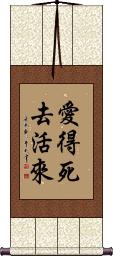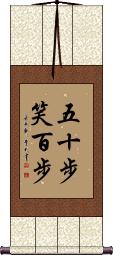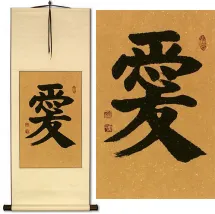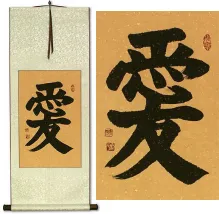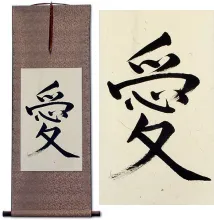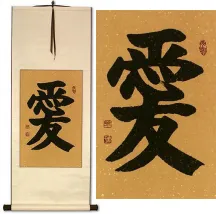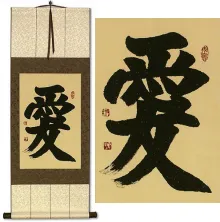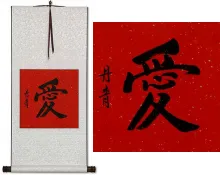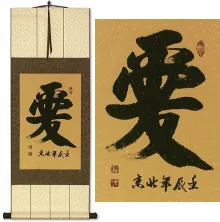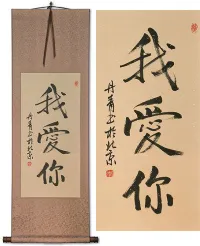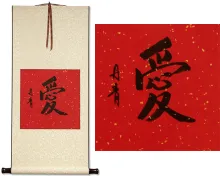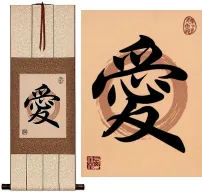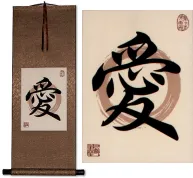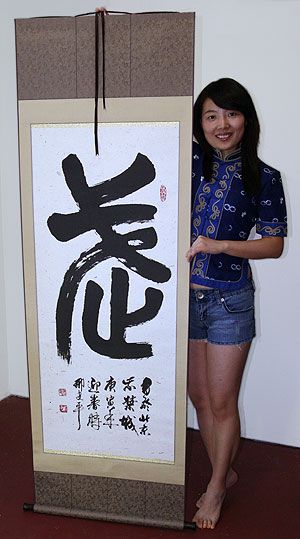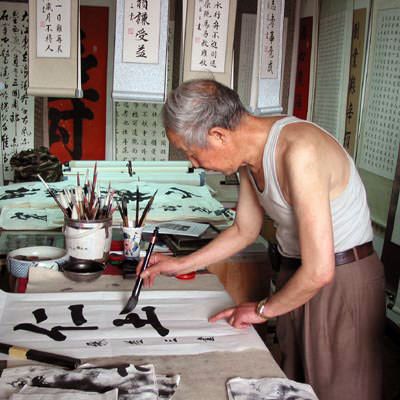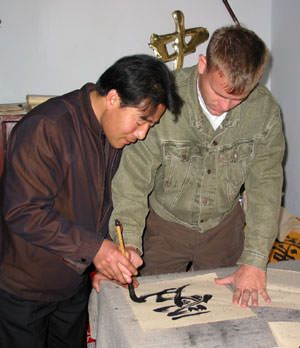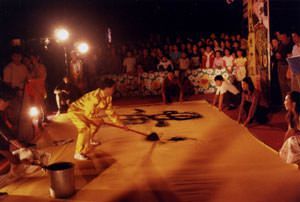Many custom options...
And formats...

Death of Love in Chinese / Japanese...
Buy a Death of Love calligraphy wall scroll here!
Personalize your custom “Death of Love” project by clicking the button next to your favorite “Death of Love” title below...
Madly in Love
The one who retreats 50 paces mocks the one to retreats 100
The pot calls the kettle black
五十步笑百步 is a Chinese proverb that means the one who retreats 50 paces mocks the one who retreats 100 paces.
During the Warring States Period of what is now China (475 - 221 B.C.), the King of Wei was in love with war. He often fought with other kingdoms just for spite or fun.
One day, the King of Wei asked the philosopher Mencius, “I love my people, and all say I do the best for them. I move the people from famine-stricken areas to places of plenty and transport grains from rich areas to the poor. Nobody goes hungry in my kingdom, and I treat my people far better than other kings. But why does the population of my kingdom not increase, and why does the population of other kingdoms not decrease?”
Mencius answered, “Since you love war, I will make this example: When going to war, and the drums beat to start the attack, some soldiers flee for their lives in fear. Some run 100 paces in retreat, and others run 50 steps. Then the ones who retreated 50 paces laugh and taunt those who retreated 100 paces, calling them cowards mortally afraid of death. Do you think this is reasonable?
The King of Wei answered, “Of course not! Those who run 50 paces are just as timid as those who run 100 paces.”
Mencius then said, “You are a king who treats his subjects better than other kings treat their people, but you are so fond of war that your people suffer from great losses in battle. Therefore, your population does not grow. While other kings allow their people to starve to death, you send your people to die in war. Is there any difference?”
This famous conversation led to the six-character proverb shown here. It serves as a warning to avoid hypocrisy. It goes hand-in-hand with the western phrase, “The pot calls the kettle black,” or the Biblical phrase, “Before trying to remove a splinter from your neighbor's eye, first remove the plank from your own eye.”
This in-stock artwork might be what you are looking for, and ships right away...
Gallery Price: $87.50
Your Price: $39.00
Gallery Price: $65.00
Your Price: $39.88
Gallery Price: $65.00
Your Price: $39.88
Gallery Price: $200.00
Your Price: $122.88
Not the results for Death of Love that you were looking for?
Below are some entries from our dictionary that may match your Death of Love search...
| Characters If shown, 2nd row is Simp. Chinese |
Pronunciation Romanization |
Simple Dictionary Definition |
五福 see styles |
wǔ fú wu3 fu2 wu fu gofuku ごふく |
(from the Book of Documents) the five blessings (health, wealth, longevity, love of virtue and dying a natural death); (place-name, surname) Gofuku five blessings |
八苦 see styles |
bā kǔ ba1 ku3 pa k`u pa ku hakku はっく |
the eight distresses - birth, age, sickness, death, parting with what we love, meeting with what we hate, unattained aims, and all the ills of the five skandhas (Buddhism) {Buddh} the eight kinds of suffering (birth, old age, disease, death, parting from loved ones, meeting disliked ones, not getting what one seeks, pains of the five skandha) The eight distresses―birth, age, sickness, death, parting with what we love, meeting with what we hate, unattained aims, and all the ills of the five skandhas. |
潤生 润生 see styles |
rùn shēng run4 sheng1 jun sheng mitsuo みつお |
(male given name) Mitsuo The fertilization of the natural conditions which produce rebirth, especially those of the three kinds of attachment in the hour of death, love of body, of home, and of life. |
玉砕 see styles |
gyokusai ぎょくさい |
(n,vs,adj-no) (1) honourable defeat; honorable defeat; honourable death; honorable death; death without surrender; (2) (colloquialism) trying but being utterly beaten; being completely rejected when professing one's love |
尼陀那 see styles |
ní tuó nà ni2 tuo2 na4 ni t`o na ni to na nidana |
nidāna, a band, bond, link, primary cause. I. The 十二因緣 twelve causes or links in the chain of existence: (1) jarā-maraṇa 老死 old age and death. (2) jāti 生 (re) birth. (3) bhava 有 existence. (4) upādāna 取 laying hold of, grasping. (5) tṛṣṇā 愛 love, thirst, desire. (6) vedana 受 receiving, perceiving, sensation. (7) sparśa 觸 touch, contact, feeling. (8) ṣaḍ-āyatana, 六入 the six senses. (9) nāma-rūpa 名色 name and form, individuality (of things). (10) vijñāna 六識 the six forms of perception, awareness or discernment. (11) saṃskāra 行 action, moral conduct. (12) avidyā 無明 unenlightenment, 'ignorance which mistakes the illusory phenomena of this world for realities. ' Eitel. These twelve links are stated also in Hīnayāna in reverse order, beginning with avidyā and ending with jarā-maraṇa. The Fanyimingyi says the whole series arises from 無明 ignorance, and if this can be got rid of the whole process of 生死 births and deaths (or reincarnations) comes to an end. II. Applied to the purpose and occasion of writing sutras, nidāna means (1) those written because of a request or query; (2) because certain precepts were violated; (3) because of certain events. |
十二因緣 十二因缘 see styles |
shí èr yīn yuán shi2 er4 yin1 yuan2 shih erh yin yüan jūni innen |
Dvādaśaṅga pratītyasamutpāda; the twelve nidānas; v. 尼 and 因; also 十二緣起; 因緣有支; 因緣率連; 因緣棘園; 因緣輪; 因緣重城; 因緣觀; 支佛觀. They are the twelve links in the chain of existence: (1) 無明avidyā, ignorance, or unenlightenment; (2) 行 saṃskāra, action, activity, conception, "dispositions," Keith; (3) 識 vijñāna, consciousness; (4) 名色 nāmarūpa, name and form; (5) 六入 ṣaḍāyatana, the six sense organs, i.e. eye, ear, nose, tongue, body, and mind; (6) 觸 sparśa, contact, touch; (7) 受 vedanā, sensation, feeling; (8) 愛 tṛṣṇā, thirst, desire, craving; (9) 取 upādāna, laying hold of, grasping; (10) 有 bhava, being, existing; (11) 生 jāti, birth; (12) 老死 jarāmaraṇa, old age, death. The "classical formula" reads "By reason of ignorance dispositions; by reason of dispositions consciousness", etc. A further application of the twelve nidānas is made in regard to their causaton of rebirth: (1) ignorance, as inherited passion from the beginningless past ; (2) karma, good and evil, of past lives; (3) conception as a form of perception; (4) nāmarūpa, or body and mind evolving (in the womb); (5) the six organs on the verge of birth; (6) childhood whose intelligence is limited to sparśa, contact or touch; (7) receptivity or budding intelligence and discrimination from 6 or 7 years; (8) thirst, desire, or love, age of puberty; (9) the urge of sensuous existence; (10) forming the substance, bhava, of future karma; (11) the completed karma ready for rebirth; (12) old age and death. The two first are associated with the previous life, the other ten with the present. The theory is equally applicable to all realms of reincarnation. The twelve links are also represented in a chart, at the centre of which are the serpent (anger), boar (ignorance, or stupidity), and dove (lust) representing the fundamental sins. Each catches the other by the tail, typifying the train of sins producing the wheel of life. In another circle the twelve links are represented as follows: (1) ignorance, a blind woman; (2) action, a potter at work, or man gathering fruit; (3) consciousness, a restless monkey; (4) name and form, a boat; (5) sense organs, a house; (6) contact, a man and woman sitting together; (7) sensation, a man pierced by an arrow; (8) desire, a man drinking wine; (9) craving, a couple in union; (10) existence through childbirth; (11) birth, a man carrying a corpse; (12) disease, old age, death, an old woman leaning on a stick. v. 十二因緣論 Pratītya-samutpāda śāstra. |
蘭摧玉折 兰摧玉折 see styles |
lán cuī yù zhé lan2 cui1 yu4 zhe2 lan ts`ui yü che lan tsui yü che |
premature death of a budding talent; those whom the Gods love die young |
Variations: |
gyokusai ぎょくさい |
(n,vs,adj-no) (1) honourable defeat; honorable defeat; honourable death; honorable death; death without surrender; (n,vs,adj-no) (2) (玉砕 only) (colloquialism) trying but being utterly beaten; being completely rejected when professing one's love |
Variations: |
gyokusai ぎょくさい |
(n,vs,vi) (1) honorable death; death without surrender; honorable defeat; (n,vs,vi) (2) (colloquialism) trying but being utterly beaten; being completely rejected when professing one's love |
The following table may be helpful for those studying Chinese or Japanese...
| Title | Characters | Romaji (Romanized Japanese) | Various forms of Romanized Chinese | |
| Madly in Love | 愛得死去活來 爱得死去活来 | ài de sǐ qù huó lái ai4 de5 si3 qu4 huo2 lai2 ai de si qu huo lai aidesiquhuolai | ai te ssu ch`ü huo lai aitessuchühuolai ai te ssu chü huo lai |
|
| The one who retreats 50 paces mocks the one to retreats 100 | 五十步笑百步 | wù shí bù xiào bǎi bù wu4 shi2 bu4 xiao4 bai3 bu4 wu shi bu xiao bai bu wushibuxiaobaibu | wu shih pu hsiao pai pu wushihpuhsiaopaipu |
|
| In some entries above you will see that characters have different versions above and below a line. In these cases, the characters above the line are Traditional Chinese, while the ones below are Simplified Chinese. | ||||
Successful Chinese Character and Japanese Kanji calligraphy searches within the last few hours...
